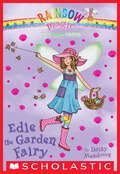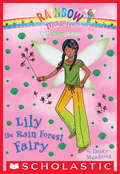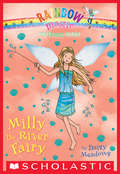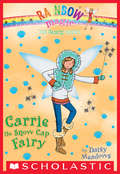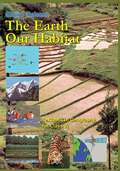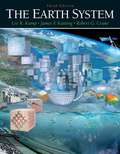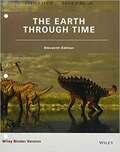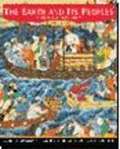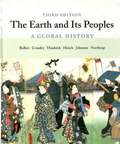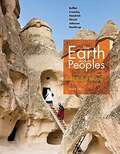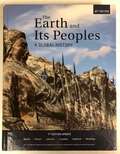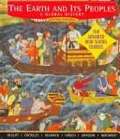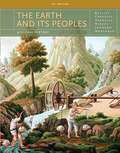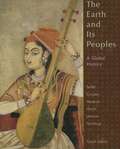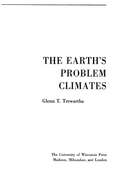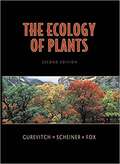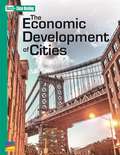- Table View
- List View
The Earth Fairies #3: Edie the Garden Fairy (The Earth Fairies #3)
by Daisy MeadowsThe fairies are going green!<P> The fairy king and queen have just put together a new team of seven fairies for a very special mission. They are the Earth Fairies! Together, they're going to work their magic to clean up the environment. But they can't do it alone. Luckily, Rachel and Kirsty are ready to help!<P> Rachel and Kirsty are volunteering for a gardening project. They're going to turn an unused lot into a beautiful garden. But first they need to find Edie's missing wand-before it's too late!<P> Find the missing magic wand in each book and help save the environment!
The Earth Fairies #4: Coral the Reef Fairy (The Earth Fairies #4)
by Daisy MeadowsThe fairies are going green!<P> The fairy king and queen have just put together a new team of seven fairies for a very special mission. They are the Earth Fairies! Together, they're going to work their magic to clean up the environment. But they can't do it alone. Luckily, Rachel and Kirsty are ready to help!<P> Coral the Reef Fairy's magic keeps the reef environment healthy. But Jack Frost's goblins have her wand and underwater environments everywhere are in trouble. Can Rachel and Kirsty find the wand and put an end to Jack Frost's plans? <P> Find the missing magic wand in each book and help save the environment!
The Earth Fairies #5: Lily the Rain Forest Fairy (The Earth Fairies #5)
by Daisy MeadowsThe fairies are going green!<P> The fairy king and queen have just put together a new team of seven fairies for a very special mission. They are the Earth Fairies! Together, they're going to work their magic to clean up the environment. But they can't do it alone. Luckily, Rachel and Kirsty are ready to help!<P> Lily the Rainforest Fairy whisks the girls away to a tropical forest to find her wand. Lily needs her wand to save the rainforest-and to get Rachel and Kirsty home safe again.<P> Find the missing magic wand in each book and help save the environment!
The Earth Fairies #6: Milly the River Fairy (The Earth Fairies #6)
by Daisy MeadowsThe fairies are going green!<P> The fairy king and queen have just put together a new team of seven fairies for a very special mission. They are the Earth Fairies! Together, they're going to work their magic to clean up the environment. But they can't do it alone. Luckily, Rachel and Kirsty are ready to help!<P> Rachel and Kirsty are helping Milly the River Fairy clean up a polluted river. But troublemaking goblins keep getting in the way. The girls need to get Milly's wand back to make the river a safe place again.<P> Find the missing magic wand in each book and help save the environment!
The Earth Fairies #7: Carrie the Snow Cap Fairy (The Earth Fairies #7)
by Daisy MeadowsThe fairies are going green!<P> The fairy king and queen have just put together a new team of seven fairies for a very special mission. They are the Earth Fairies! Together, they're going to work their magic to clean up the environment. But they can't do it alone. Luckily, Rachel and Kirsty are ready to help!<P> Rainspell Island's weather is wacky-and it's all because Carrie the Snow Cap Fairy's magic wand is missing. Her magic helps keep the earth's climate under control. Rachel and Kirsty are determined to outsmart Jack Frost and keep the earth clean and green! <P> Find the missing magic wand in each book and help save the environment!
The Earth Our Habitat - geography textbook for class 6 - competitive exam - Ncert
by NcertThe Earth Our Habitat - Textbook Social Science for Class - 6 - 656
The Earth System
by Lee Kump Robert Crane James KastingThe first book of its kind to address the issues of global change from a true Earth systems perspective, The Earth System offers a solid emphasis on lessons from Earth's history that may guide decision-making in the future. The authors' systems theory approach looks holistically at all that happens on Earth and the interactions of all that is here--such as the effect of weather on land, the effect of erosion on the ocean, the chemical changes that occur--and emphasizes that these processes do not happen in a vacuum. An emphasis on global change addresses such modern issues as global warming, ozone depletion, and biodiversity loss.A variety of boxed inserts address topical issues related to the material presented, giving readers appealing visual and highlighted aids. KEY TOPICS: Global Change; Daisyworld: An Introduction to Systems; Global Energy Balance: The Greenhouse Effect; The Atmospheric Circulation System; The Circulation of the Oceans; The Cryosphere; Circulation of the Solid Earth: Plate Tectonics; Recycling of the Elements; Focus on the Biota: Metabolism, Ecosystems and Biodiversity; Origin of the Earth and of Life; Effect of Life on the Atmosphere: The Rise of Oxygen and Ozone; Long-Term Climate Regulation; Biodiversity Through Earth History; Pleistocene Glaciations; Global Warming, Part 1: The Scientific Evidence; Global Warming, Part 2: Impacts, Adaptation, and Mitigation; Ozone Depletion; Human Threats to Biodiversity; Climate Stability on Earth and Earth-Like Planets. MARKET: A useful reference for anyone who wants to learn more about Earth processes to become a more well-informed consumer.
The Earth System: Investigating Water Shortages, Investigation Notebook
by The Lawrence Hall of ScienceNIMAC-sourced textbook
The Earth Through Time
by Harold L. Levin David T. King Jr.The Earth Through Time, 11th Edition, by Harold L. Levin and David T. King chronicles the Earth's story from the time the Sun began to radiate its light, to the beginning of civilization. <p><p> The goal of The Earth Through Time is to present the history of the Earth, and the science behind that hsitory, as simply and clearly as possible. The authors strived to make the narrative more engaging, to convey the unique perspective and value of historical geology, and to improve the presentation so as to stimulate interest and enhance the reader's ability to retain essential concepts, long after the final exam.
The Earth and Its Peoples: A Global History
by Daniel R. Headrick Pamela Kyle Crossley Richard W. Bulliet Lyman L. Johnson David Northrup Steven W. HirschThis is a textbook that not only speaks for the past but speaks to today's student and today's teacher. The book explores the common challenges and experiences that unite the human past. The Earth and Its Peoples is a truly global text that employs a fundamental theme, the interaction of human beings and the environment, as a point of comparison for different times, places, and societies.
The Earth and Its Peoples: A Global History
by Daniel R. Headrick Pamela Kyle Crossley Richard W. Bulliet Lyman Johnson Steven HirschThis text provides a truly global approach to the world history survey. Its fundamental theme, the interaction of human beings and the environment, serves as a point of comparison for different times, places, and societies. Special emphasis is given to technology and how technological development underlies all human activity. The Third Edition combines strong scholarship and pedagogy to uphold the book's reputation for rigor and accessibility. Several features, such as detailed maps, images, and timelines, help students build their geography and comparative analysis skills.
The Earth and Its Peoples: A Global History
by Richard W. Bulliet Lyman L. Johnson Steven W. HirschNIMAC-sourced textbook
The Earth and Its Peoples: A Global History
by Richard W. Bulliet Lyman L. Johnson Steven W. HirschNIMAC-sourced textbook
The Earth and Its Peoples: A Global History (2nd Edition)
by Daniel R. Headrick Pamela Kyle Crossley Richard W. Bulliet Lyman L. Johnson David Northrup Steven W. HirschThe book explores the common challenges and experiences that unite the human past and contains The Emergence of Human Communities, To 500 B.C.E., The Formation of New Cultural Communities, 1000 B.C.E-400 C.E., Growth and Interaction of Cultural Communities, 300 B.C.E.-1200 C.E., Interregional Patterns of Culture and Contact, 1200-1550, The Globe Encompassed, 1500-1750, Revolutions Reshape The World, Global Dominance and Diversity, The Perils and Promises of A Global Community, 1945-2000.
The Earth and Its Peoples: A Global History (AP Edition)
by Daniel R. Headrick Pamela Kyle Crossley Richard W. Bulliet Lyman L. Johnson David Northrup Steven W. HirschNIMAC-sourced textbook
The Earth and Its Peoples: A Global History (AP Edition)
by Daniel R. Headrick Pamela Kyle Crossley Richard W. Bulliet Lyman L. Johnson David Northrup Steven W. HirschThe AP World History exam consists of two section: Section I has seventy multiple-choice questions that make up half of your overall exam score. Section II has three parts. Section II, Part A, is the document-based question (DBQ); Section II, Part B, is the continuity and change over time question; Section II, Part C, is the comparative question.
The Earth and Its Peoples: Since 1500 (Brief Edition, Sixth Edition)
by Daniel R. Headrick Pamela Kyle Crossley Richard W. Bulliet Lyman L. Johnson David Northrup Steven W. HirschThis book provides the essential narrative of world history in an abbreviated format.
The Earth and its Peoples: A Global History
by Richard W. BullietIn this updated and reorganized edition, Bulliet (Middle Eastern history, Columbia U. ) and historians with other US colleges trace the emergence and growth of civilizations in various regions up to the present globalized world. They examine such major themes as technology and the environment, climate and population, and questions of identity. The well-illustrated text newly includes original essays, a primary source feature, and an auxiliary online study guide. Dates are not given for previous editions.
The Earth's Problem Climates
by Glenn T. TrewarthaLatin America; Australia-New Zealand-Equatorial Pacific; Africa-Southern and Eastern Asia; Europe and the mediterranean Borderlands; Anglo-America.
The Earth: Our Habitat class 6 - NCERT - 23
by National Council of Educational Research and Training"The Earth: Our Habitat" is a comprehensive textbook designed for sixth-grade students studying geography. This book delves into the intricate details of our planet, exploring various geographical aspects crucial to understanding Earth as our habitat. It covers diverse topics, such as the structure of the Earth, its landforms, climate patterns, natural resources, and the significance of environment conservation. The content is presented in a student-friendly manner, incorporating vivid illustrations, maps, and engaging exercises to facilitate better comprehension. The book aims to foster a deep appreciation for the Earth's complexity and its role as the ultimate home for all living beings. Through its detailed exploration of geography, "The Earth: Our Habitat" intends to instill a sense of responsibility among young learners towards preserving and nurturing the environment. Overall, it serves as a foundational guide, encouraging students to grasp the fundamental concepts of geography while emphasizing the importance of caring for our planet, ensuring a sustainable future for generations to come.
The Earth’s Inner Core: Revealed by Observational Seismology
by Hrvoje TkalčićThe inner core is a planet within a planet: a hot sphere with a mass of one hundred quintillion tons of iron and nickel that lies more than 5000 kilometres beneath our feet. It plays a crucial role in driving outer core fluid motion and the geodynamo, which generates the Earth's magnetic field. This book is the first to provide a comprehensive review of past and contemporary research on the Earth's inner core from a seismological perspective. Chapters cover the collection, processing and interpretation of seismological data, as well as our current knowledge of the structure, anisotropy, attenuation, rotational dynamics, and boundary of the inner core. Reviewing the latest research and suggesting new seismological techniques and future avenues, it is an essential resource for both seismologists and non-seismologists interested in this fascinating field of research. It will also form a useful resource for courses in seismology and deep Earth processes.
The Ecology Of Plants
by Gordon A. Fox Jessica GurevitchNow in full color, this thoroughly revised and updated second edition of The Ecology of Plants incorporates many new illustrations and hundreds of new references. The text covers a range of topics that you might find in a general ecology textbook, but with the focus on the interactions between plants and their environment over a range of scales. Some of the subjects covered are unique to plants, such as photosynthesis and the ecology of plant--soil interactions; other topics, such as resource and mate acquisition, emphasize the distinctive ways plants (in contrast to mobile animals) deal with their environments. The book is unusual in emphasizing the importance of evolutionary and other historical processes for current ecology. Throughout the text, human environmental influences are discussed. While the book is written for an undergraduate college course in plant ecology, the engaging style, thorough coverage of the field, and contemporary perspective make it accessible and useful to others as well, from graduate students in conservation biology to evolutionary biologists and resource managers.
The Economic Development of Cities: Unit Nine
by Benchmark Education CompanyNIMAC-sourced textbook <p>Grade 5</p>
